Creed
Pro Diver
  
Posts: 189
|
Post by Creed on Jul 21, 2006 12:29:45 GMT -8
OK, I just got my Healthways body back from the machine shop. They drilled a new set of lever mount holes for me, which lined the levers up at a 90 degree angle to the inhalation port. It definitely makes a difference, with one of my Healthways now breathing about the same as my DA which VDH rebuilt and tuned for me. I'm also going to experiment with a small plate to direct the airflow even more towards the inhaltion port, and partially block off the airflow on the other side of the levers. I'll post the results of a pool test when I get a chance to go.
|
|
|
|
Post by SeaRat on Jul 21, 2006 15:14:48 GMT -8
Creed,
You know that this is what the Healthways Scuba Deluxe (yellow label) has--an actual orifice with a plate over the top of the body. It makes a great regulator, and I think you're really going to like what you've now got. Keep us informed on how you do it, as I like the "guts" of the Healthways better than the Mistral.
John
|
|
Creed
Pro Diver
  
Posts: 189
|
Post by Creed on Jul 24, 2006 15:38:02 GMT -8
I made a restictor plate today out of a 1-1/2" washer. I drilled two mounting holes, and used a dremel with a cutting wheel to make two slits on one side. I then used a vise and some pliers to bend the resulting flap out. I'll post some photos when I have some time, perhaps tonight.
|
|
Creed
Pro Diver
  
Posts: 189
|
Post by Creed on Aug 2, 2006 12:22:09 GMT -8
OK, finally got a couple of minutes to post a few photos. Here is a topside view of the restrictor plate.  A side view, showing the slight angle of the flap.  Here is the plate on top of the valve body. The white looking areas are where I ground the ridges resulting from the drilling off of the plate.  Here is a shot of the new holes I drilled. You can visualize how it orients the lever assembly 90 degrees to the inhalation port.  |
|
|
|
Post by SeaRat on Aug 23, 2007 20:27:28 GMT -8
Creed, It's been about a year since we discussed the Healthways Scuba double hose regulators. At one point above, I made this statement: Well, last week I broke down, and bid on a Healthways Scuba which I was fairly sure was the third generation of that regulator. I've had one before, and now I again have this wonderful regulator. The one I received had decayed rubber hoses, and the exhaust valve had disintegrated onto the diaphragm. The diaphragm itself looks like I co rehab it, although I have others if necessary. I am excited about getting this regulator, and I got it for just under $100 total. It is a better breathing regulator than a USD Mistral, if you use USD hoses on it. When I received it last night, I looked inside to make sure that it had the air ejector cover, and it does, so I'm set now with it. I have a spare set of hoses for it too. I'm even thinking of using this valve body with the original Scuba regulator boxes, and trying that out as an improved version with the original exhaust system. It should be an interesting winter project. Here's the photos I received via e-bay:  The regulator has not been maintained, as you can see. The box is even misdirected.  From the rear, this shows the unique yolk system of the third generation, which has an internal knob rother than a yolk screw. They advertised this as a feature which would not hang up on nets and kelp.  This shows the mouthpiece system. In my opinion, which I've recently reviewed and found true, the Healthways mouthpiece system was really poor, and perhaps doomed this regulator. With this mouthpiece, it could not compete with the USD Mistral, which was its main competitor.  This shows the deteriorated mouthpiece system. I may elect to replace it with a set of hoses I bought from Dan, which are 1 inch on each end and have that marvelous stretching ability. You can see them at: www.vintagescubasupply.com/hoses.htmlThey are the #SDSH, 18 inch long super flex hoses. I put them onto a Hope-Page mouthpiece system for use with my Sportsways Hydro Twin, and may also use them with this Healthways Scuba Delux regulator.  This is the undersized mouthpiece. I have used it recently, as is shown in this underwater photo: 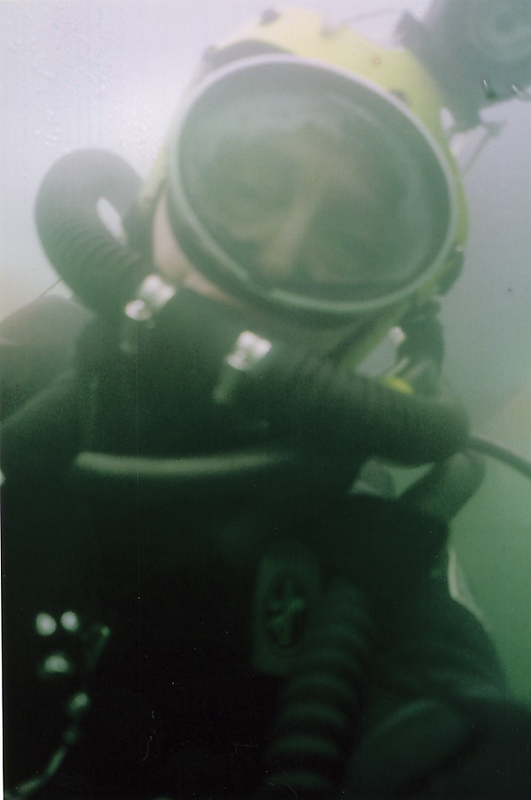 But the one I used had the inhalation matrix bored out, so that it was a one-inch wide opening without a non-return. That worked adequately. Well, that's my new project. John |
|
Deleted
Deleted Member
Posts: 0
|
Post by Deleted on Aug 24, 2007 10:38:05 GMT -8
 Hi  I have a NOS & New In it's Original Helathways Box.___ It is a Healthways "SCUBA", Gold Label Double Hose Regulator, so now, I will have to try and find where it is stored, ha,ha and dig it out to see if there is also a Healthways Manuel in it's Box.  William
|
|
Creed
Pro Diver
  
Posts: 189
|
Post by Creed on Aug 24, 2007 20:48:26 GMT -8
My newest experiment with the Healthways involved rebuilding it with a few new parts: 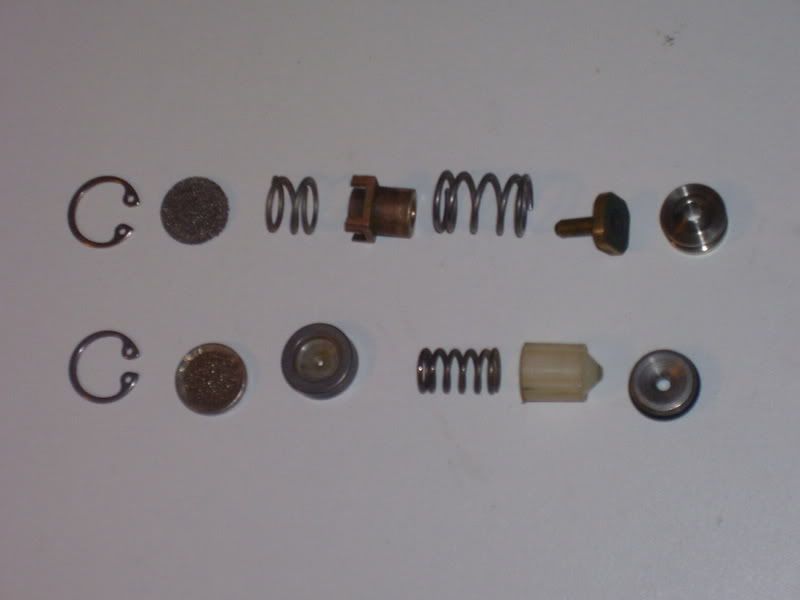 The bottom row are the original Healthways internals. The top are slightly modified Conshelf internals, along with a USD Titan orifice. The practical upshot is that my unbalanced single stage is now a balanced single stage similar to the USD Royal Mistral. This was achieved without any machining of the Healthways body(however, this IS the body I earlier made some adjustments to by drilling new lever mounting holes). |
|
|
|
Post by SeaRat on Aug 24, 2007 22:06:05 GMT -8
So, now we have a Healthways Royal Scuba Deluxe regulator! How neat (to borrow an old phrase).
Tonight I've been experimenting a bit too, and found that the Scuba Deluxe 16A valve body will fit into the older, first Healthways Scuba regulator. That valve body has a very efficient venturi tube pointed right down the hose, with two small outlet holes in it which feed the main chamber (preventing a total venturi suction). So that part is possible too.
Also, the original Healthways Scuba regulator had a very unique exhaust, which originally did not have a duckbill valve. The later duckbill was put in "to back up the other two exhaust systems," according to Fred Roberts. Tonight I took out that exhaust diaphragm (the big one which seals the exhaust tube from inside) and will be substituting a different material, which I'll glue in place. The reason is that the original exhaust was too inflexible to actually make a seal. This new system is made out of a material which will seal, and I think can be glued into place. If that is the case, then I will have a souped-up Scuba regulator with the deluxe body, and an improved exhaust system. I'll probably start glueing on it this weekend.
Interesting stuff--a balanced single stage, and a reconfigured original regulator. Now if we mate those two...
John
|
|
|
|
Post by SeaRat on Aug 26, 2007 21:28:32 GMT -8
I just put my Healthways Scuba Deluxe together after cleaning it, and I replaced the case exhaust mushroom with one of Dan's. Wow, this regulator is quite something. I now have three regulators which have such an efficient venturi that they will continue flowing air once the breath is initiated after the diver (me) takes his mouth away from the mouthpiece. It is a really nice regulator, and I'll put it up against the USD Mistral (old) any day. It may even approach the New Mistral at lower tank pressures.
I have two hose/mouthpiece systems for it. One consists of two original Healthways hoses with a modified mouthpiece, in that the inhalation side has been cleaned out so that there is no inhalation non-return, but it does have the exhalation non-return with Dan's silicone mushroom valve. I also have a hose/mouthpiece system which consists of Dan's flexible hoses on a Hope-Page mouthpiece system. This latter is the better of the two, and it breathes wonderfully.
When I put it together, I thought I might have to adjust the lever height, as there was a slight leak which went away when I broke open the case. But I worked on the diaphragm, making sure it was all the way out (it is a rubberized fabric, original design, and not as pliable as a silicone diaphragm, but very durable). I put it back together, got complete lockup, and no leakage. So I'm set now. Soon, I'll try it out in open water.
John
|
|
Deleted
Deleted Member
Posts: 0
|
Post by Deleted on Aug 28, 2007 0:15:37 GMT -8
John,
Interesting project. I often find that when I am working on a project it helps to to a kite string to the regulator and fly the kite during an electrical storm. Hope this helps.-Jim
|
|
|
|
Post by SeaRat on Dec 9, 2007 19:12:17 GMT -8
I have just cobbled together a combination regulator, which consists of the old Healthways Scuba top and bottom box, and the Scuba Deluxe parts. What this does is to utilize the exhaust of the original Healthways Scuba, along with the improved orifice of the Scuba Deluxe and the new yolk system, to create a hybrid regulator.
I also replaced the exhaust diaphragm (#1611-52) with a piece of latex from a latex cleanroom glove. My experience was that this exhaust diaphragm never did work properly to provide a seal on the inner tube of the original Healthways Scuba, necessitating an auxillary duckbill. Now, I think that this arrangement will work, as the latex does seal quite nicely against the inner tube. I know this as I had the intake non-return in the mouthpiece removed to improve air flow on the regulator, and by causing pressure back through the intake side, I caused this diaphragm to seal and create a very large resistance against exhaling (I also had a stuck exhaust auxiliary valve, which is a rubber band around the holes in the exhaust tube). Replacing the mouthpiece intake non-return, and ensuring that there were no leaks in the HP stage (the levers were originally set a bit high) solved that problem.
This is exciting, as I am going to put it into the water next weekend to see how it works. It will truly be a hybrid regulator, and if it works well, I may incorporate the Conshelf innards that we discussed above to have a very interesting, balanced single stage regulator that looks like the original Healthways Scuba regulator, my first regulator in about 1959.
John
|
|
Creed
Pro Diver
  
Posts: 189
|
Post by Creed on Dec 10, 2007 9:09:32 GMT -8
Nice! I look forward to hearing how your new exhaust diaphragm works in the water!
|
|
|
|
Post by SeaRat on Dec 17, 2007 21:53:57 GMT -8
Yesterday (Sunday) I finally got to dive my hybrid Healthways Scuba Deluxe regulator. I went to the pool, and unfortunately there was a dive meet going on, so no scuba was what they told me. The kayakers were in the shallow end, and their paddles would be a hazard to us divers in the shallows, so no diving. Well, I talked and hung around long enough that they had pity on me, and said I could scuba dive an noon instead of the normal 10:00 PM. I had my twin 50s (at about 2600 psig), my Healthways Scuba Deluxe hybride (original Healthways Scuba top box and cover), and the new exhaust diaphragm that I had put on it from a latex cleanroom glove. If you'll look at Creed's photos above, that big black oval thing is the original diaphragm, made of rubberized fabric, that came with the regulator. But it never worked very well, and evantually a backup duckbill valve was installed just upstream of it in the metal tube. That's how it was sold and marketed.
Well, I wasn't satisfied with that, and so have tried to modify it. I used a heavy guage plastic first, and glued it in place, but that did not work as it also was too stiff. Then about a week ago, I looked on one of these gloves that I was using for my dirty bicycle work, and decided to put it onto the Healthways Scuba box. I used the same double wire to secure it, and it seemed to work. I confirmed this when I put hoses on it without o non-return valve on the inhalation side of the mouthpiece (a Hope-Page mouthpiece), and found tremendous breathing resistance for exhaling. I put the non-returns into the mouthpiece, and the regulator worked well on land. What had happened is that the lack of an intake non-return allowed pressure to build in the interior of the regulator, and seal shut the exhalation valve. So I was anxious to try it in the water.
Finally, I was able to get into the water, but I needed to jump in as there was no ladder. This was a bit problematical, as I was not sure that the very thin latex would hold through this heavy pressure change from the jump. But it did, and so I put on my fins, and tried it out. The regulator's exhaust seemed to work well as I was sitting vertically, and as I swam horizontally. But when I put the regulator head-down, then a bit of water did enter into the exhaust hose. I blew it dry, then resumed my swimming. I did several lengths this way, until I had a good idea of the performance of the valve. It worked well in normal swimming positions, but for descent, the water would enter the hose. I also was getting some water into the regulator itself, so I did a doff underwater and examined it as I breathed through it while it was in front of me. The water was coming from a small leak in the case where the clamp should have made a seal to the diaphragm. I was using the older of the two styles of clamps (to maintain the Healthways Scuba look), and had not tightened it enough. I was also unsure whether there was a leak in the exhaust diaphragm that I had made.
I switched regulators. I took that regulator off, and put on a AMF Voit Blue Fifty Fathom (with a USD box), and tried that. That is really a nice regulator. I then took it off, and put on my old trusty Mistral (with the USD Aqualung bottom box--'sorry Chuck, but I still like that arrangement, as it allows better use of the duckbill). It worked extremely well too.
The diving competition was completed, and I asked whether I could go into the deep end. The lifeguards said that was now okay, so after switching back to the Healthways Scuba Deluxe hybrid, I went under the barrier and into the deep end. The regulator exhaust functioned quite nicely, again until I went upside down or head down, where a bit of water did get into the exhaust hose again. It was not difficult to get rid of it, but there was more exhalation resistance when I did so. But in normal dive positions, with the regulator either face down or angled upwards (vertical, as in ascending), there was no problem at all, and breathing resistance was very low.
This regulator was developed by Healthways "under the direction of Gustav Dalla Valle, skin diving pioneer..." according to the February 1959 article on the Healthways Scuba regulator in Skin Diver Magazine. I'm sure he was tyring hard to get around the Cousteau patent, which was for the exhaust system of the original Aqualung. Using a different type of exhaust, with a diaphragm inflated by air pressure against an inner tube, would allow Healthways to skirt the Cousteau patent. While it worked, it did not work as well as the original Aqualung duckbill valve against the diaphragm. It did have a positional problem, which could not be overcome because of the difference in air pressure which would prevent a complete seal in some positions. But it was a very good try, and in a normal diving horizontal or ascending position, it breaths very well. But this exhaust is unique, and is described by Fred Roberts in some detail:
I have found that the exhaust diaphragm probably never did seal that well, as it was a tougher rubberized fabric, and not too flexible. That is why I am experimenting with the latex sheet material. I looked at the valve I had made after the dive, and found it still intact and functioning. It did have a few wrinkles in it, so I replaced it with another cleanroom glove, and this time took the time to pull the wrinkles out of it. The new diaphragm now functions as well is it can, and to design specifications. It still leaks into the exhaust hose in certain positions, but I'm going to live with that for now, and try it out in the pool some more.
I DO NOT RECOMMEND THAT ANYONE TRY THIS WITH THIS REGULATOR, AS A RUPTURE OF THIS MEMBRANE (AND THAT'S ALL THE LATEX IS NOW FOR THE EXHAUST DIAPHRAGM) WILL CAUSE A CATASTROPHIC REGULATOR FLOOD AND LOSS OF FUNCTION OF THIS REGULATOR!!![/U][/I] But as a concept, I want to evaluate the different exhaust against the duckbill exhaust and the mushroom valve that Healthways subsequently went to.
When Healthways put the first mushroom valve onto the newly designed Scuba Duluxe (Blue Label) regulator, it did now do well, as the diaphragm seated against the mushroom and prevented exhalation. In their second generation of the Scuba Deluxe (Gold Label), they placed a little metal flap 3/8 or so inch high next to the top of the mushroom valve, and that kept the diaphragm from seating against the mushroom and preventing exhalation.
But the original design, with the exhaust diaphragm, intrigues me, and I will be using it a bit more without the backup duckbill inside the intake. My initial evaluation yesterday confirmed what the marketplace told us, and that is that the duckbill was superior to this exhaust diaphragm design exhaust system. But it was a very good try by Gustav Dalla Valle and company.
John
|
|
|
|
Post by SeaRat on Dec 22, 2007 11:31:20 GMT -8
Last Wednesday I took the Healthways Scuba hybrid back into the pool, and confirmed that there was a positional problem for water leaking into the hoses. I wanted to use up the rest of the air from my twin AL 50s, and so made another pool dive. The exhalation is great when in a vertical position, or regular swimming position (again, this was with the latex membrane rather than the regular diaphragm on the regulator).
When I went into the pool, a lifeguard asked me to look for a diamond earring that had been recently lost by a woman doing water aerobics. I searched the entire pool, and didn't see it (had to dodge the kayakers too--it is a scuba/kayak session). But when I was about to surface to change regulators, I saw the earring in a shallow area near the pool's edge. I picked it up, doffed fins and mask, walked up the walkway out of he pool, and handed it to the lifeguard. She was appreciative.
I then switched to my DX overpressure breathing regulator, and the difference was striking. The DX beat the Healthways hybrid substantially. It is a great regulator with longer hoses. The internal hose provides a really effortless venturi. I saw where one of these was recently on e-bay, and went for over $400. It is worth it. But replace the hoses with Dan's 18 inch superflex (#SDSH) hoses, and it will perform really well.
I put the Healthways Scuba regulator back on the twin 50s, and used up the rest of the air. It has the restrictor orifice, and that really works. The performance drop off is very noticeable. I tripped the 500 psi J-valve, and surfaced.
It was a good session, but I think this is the last time for the hybrid. I'm going to move the Scuba Deluxe innards back to the original case, as it is very well designed with a mushroom valve. I'll put the original Healthways Scuba back into it's original configuration, but may keep the membrane on it just to check the original out in the pool sometime.
I must say that Dan's superflex hoses mentioned above work extremely well with a Hope-Page mouthpiece. It is very comfortable, and give a lot of freedom of motion.
John
|
|
|
|
Post by SeaRat on Dec 29, 2007 21:58:48 GMT -8
Here are the photos of the Healthways Scuba Hybrid regulator, first on the outside: 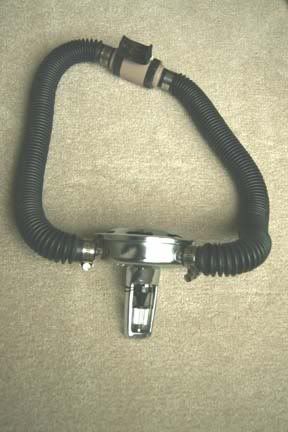 Looking from the top, you can see the inner workings of the Gold Label Scuba Deluxe: 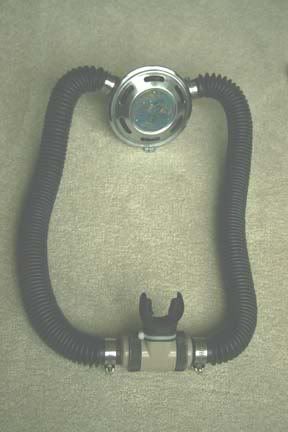 Below shows the latex rubber diaphragm that I used for the experiments. Note the amount of water in the regulator case, a week after the dive. 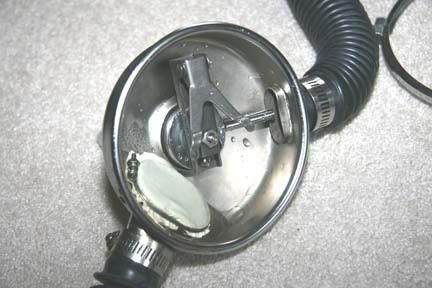 This photo shows better the effect of the air pressure, here simulated by my thumb, in closing the exhaust tube of the regulator's exhaust. Note that this only works in "most" positions, but not in a head-down position. 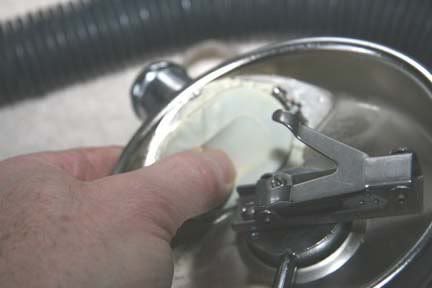 Here is a photo with the diaphragm removed, showing the inner exhaust tube. It also shows quite well the third generation Healthways Scuba air injector, which was at least the equivalent of the USD Mistral in efficiency for breathing resistance when using the USD hose/mouthpiece system (the Healthways hose/mouthpiece system was vastly inferior to the USD hose/mouthpiece system). With the USD hose/mouthpiece system, a baffle plate needs to be placed into the mouthpiece to prevent blow-by of air out of the system. With the Hope-Page mouthpiece, because the non-return valves are more inefficient (not silicone), there is enough resistance that this baffle plate is not necessary, while maintaining Mistral-like performance.  Finally here are two photos of the case designs of the three Healthways Scuba two-hose models, the original Healthways Scuba, the Scuba Deluxe (Blue Label), and the Scuba Deluxe (Gold Label). 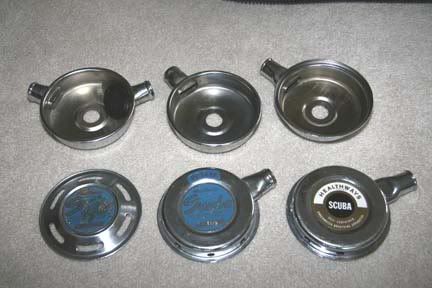 The exhaust systems evolved from the exhaust tube/diaphragm to the mushroom valve, to a modified mushroom valve that had a tab which prevented the exhaust from being inadvertently closed by the main diaphragm. 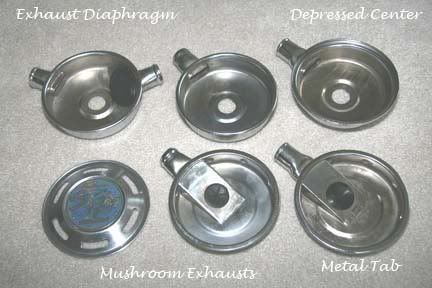 Here is a closeup of the difference in the two exhaust openings, one without the metal "L" tab and one with it: 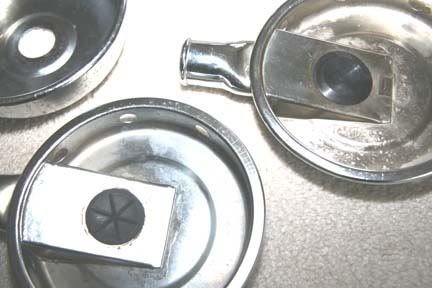 I have ended my Healthways Scuba Hybrid experiments, as I deemed them too dangerous to take into open water. The exhaust diaphragm made of latex was simply too fragile to use in open water, and indeed did leak somewhat too. I have put my Healthways Deluxe Gold Label back together, but with the original Hope-Page mouthpiece system from the original Healthways Scuba regulator, as it was of much better quality than the very small mouthpiece and short hoses of the second and third generations. I have also added Dan's quality superflex hoses (see above), which significantly improves the whole system. John |
|